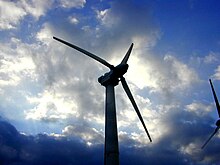Ka Lae
South Point Complex | |
 Rocky cliffs of Ka Lae | |
| Location | Big Island of Hawaii |
|---|---|
| Nearest city | Nā'ālehu |
| NRHP reference No. | 66000291 |
| Added to NRHP | October 15 1966 |

Ka Lae ("the point" in Hawaiian), also known as South Point, is the southernmost point on the island of Hawaiʻi and in the state of Hawaii, and is also the southernmost point in the United States, at an approximate latitude of 19° North. The Ka Lae area is registered as a National Historic Landmark District.
A confluence of ocean currents just offshore makes this spot one of Hawaii's most popular fishing spots. Both red snapper and ulua are plentiful here. Locals fish from the cliffs, some dangling perilously over the edge of steep lava ledges. Swimming here, however, is not recommended, due to the current. In fact, it is called the "Halaea Current", named after a chief who was carried off to his death.[1]
The confluence of currents also means the area is prone to accumulation of marine debris. Most of this coastline is very remote and difficult to access, and is probably the most debris-littered coast in the state, primarily due to its difficult access for debris removal. This debris poses an entanglement threat to wildlife and may refloat during storms. The shoreline is used by Hawaiian Monk Seals and hatchling Hawksbill turtles, both endangered species. Efforts to clean the coastline are organized by the Hawaii Wildlife Fund in conjunction with the NOAA.[2]
Ka Lae is the site of one of the earliest Hawaiian settlements and it is speculated that this is where the Polynesians first landed due to the fact that the Big Island is the closest of the Hawaiian Islands to Tahiti, and Ka Lae would be the first landfall.[3] Ruins of a heiau and a fishing shrine can be found here. In addition, ancient Hawaiians drilled numerous holes in the rock ledges to use for mooring their canoes. Tying long ropes to their boats, they would drift out to sea to fish without fear of being carried away by the strong currents.[4] Evidence suggests that people have been in the area since C.E. 200.[1]

The area is also known for its strong winds and is the home of a wind farm. Some trees are almost horizontal with their branches all growing in the same direction near the ground.
Ka Lae is accessible via South Point Rd., a 20-mile (32 km) tarmac road leading from State Highway 11, the turn off being about 7 miles (11 km) west of the village of Nā'ālehu. The Kamaoa and Pakini Nui Wind Farms are located alongside the road, as well as the large shortwave radio antennas of KWHR and a 13-meter parabolic antenna of the Universal Space Network. A fork is at the end of the tarmac road, with one dirt road leading to Ka Lae and the other to Green Sands Beach.
The other extremity of the island is Upolu Point. Ballast Key, Florida is the southernmost point in the continental United States.
Wind farms

The Kamaoa Wind Farm consisted of thirty-seven 250 kW wind turbines with an operationally typical total peak output of 7.5 MW. As of 2006 the turbines were falling into disrepair, and they were finally shut down on August 15 2006. At the end of August 2006, components for a new set of wind turbines were transported to South Point - the Pakini Nui project consists 14 wind turbines to be constructed about 1.5 miles (2.4 km) from the old Kamaoa wind farm. When complete, Pakini Nui will supply up to 20.5 MW of power to the island electricity grid. At late 2006 levels, this would be about 6.5% of the total 300 MW Big Island electricity supply.
References
- ^ a b "Kaʻu". Coffee Times.
- ^ "Marine Debris Removal from the Waiohinu-Ka Lae Coast Hawaii Island". Marine Debris Program. NOAA. September 18, 2006.
- ^ "Ka Lae, Ka'u, Kailua-Kona". Kailua-Kona Travel Guide. Virtual Tourist. October 5, 2002.
- ^ Bendure, Glenda (1997). "Hawaii — The Big Island". Hawaii (4th ed. ed.). Australia: Lonely Planet. pp. 327–28. ISBN 0-86442-489-2.
{{cite book}}:|edition=has extra text (help); Unknown parameter|coauthors=ignored (|author=suggested) (help); Unknown parameter|month=ignored (help)
